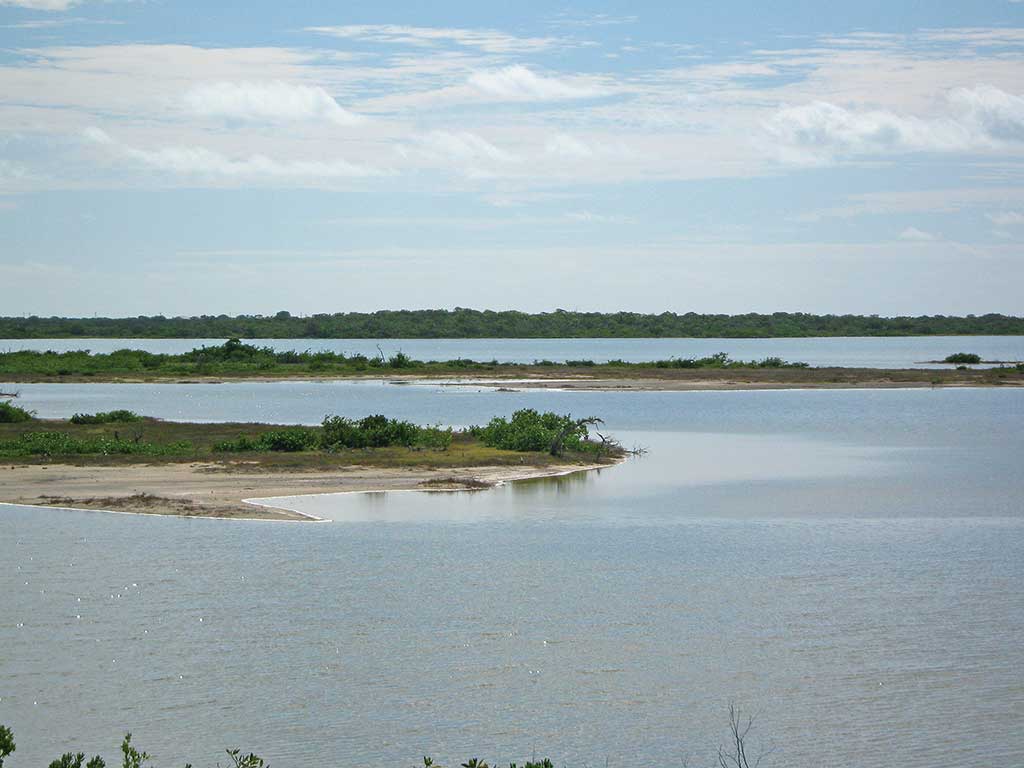Anegada’s Western Salt Ponds, declared a wetland of international importance under the Ramsar Convention in 1999, cover more than a third of the island. They are home to migrating seabirds and shorebirds and are an important spawning area for a type of mullet fish. Before refrigeration, islanders used salt from the ponds to preserve meat and fish.
Be mindful that these lands are protected, so fishing, hunting, and otherwise extracting materials or animals from the ponds are illegal.The ponds are a bird-watcher’s paradise. The UK-based Darwin Initiative created a comprehensive list of species present. A trained eye will spot ducks, plovers, sandpipers, herons (including great blue herons), kingfishers, falcons (including peregrine falcons), and flamingos, the most well-known birds to inhabit the ponds.
The Western Salt Ponds are good for bird-watching. Photo © Susanna Henighan Potter.
Greater flamingos are native to Anegada but by the 1980s were all but gone. In 1990, 20 birds were reintroduced in the Western Salt Ponds, where, to the delight of conservationists and the National Parks Trust, they have reproduced steadily and attracted several volunteers looking for a new place to live. Estimates are that as many as 200 flamingos now call Anegada home.
It can be difficult to see the shy creatures, who spend most of their time wading in the parts of the salt ponds farthest away from roads and people. As you drive around the ponds, keep your eyes peeled for small dots of pink in the distance. Ask around in advance to find out which pond the birds have been frequenting recently. Regardless, binoculars are the best way to watch the birds, and a telephoto lens is required if you want to take good pictures of them. These wild flamingoes are not accustomed to people, so above all else don’t try to get near them. Your presence will interfere with nesting, breeding, and feeding, and therefore threaten their continued survival.
The ponds are surrounded by scrubby plants, including several species of mangrove and a number of succulents, including one that Anegadians add to salads for a sharp, briny flavor. You will need a guide to help you identify this plant; don’t start nibbling on everything you see. Keep your eyes open for Anegada’s endemic plant species: Acacia anegadensis (poke-me-boy), Metastelma anegadensa (wire wist), and Cordial rupicola (black sage).
The Western Salt Ponds are a minimalist landscape: flat, mostly empty, with understated colors. Most tourists don’t give them a second glance. But those who do are rewarded; they are uniquely beautiful and can be a nice place to walk if you grow weary of the beach—just keep track of your route so you don’t get lost. A number of narrow roads feeding off the main road that circles the island provide easy access to the ponds. Keep in mind that the ponds expand and contract depending on the amount of rainfall, so be careful not to drive too close and get stuck in soft spots. Also be mindful that these lands are protected, so fishing, hunting, and otherwise extracting materials or animals from the ponds are illegal.
Excerpted from the Sixth Edition of Moon U.S. & British Virgin Islands.